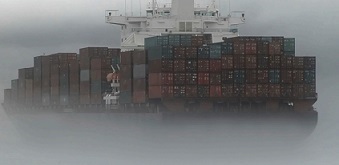Ships navigation in restricted visibility check item
It is vital that an efficient lookout is maintained by the O.O.W. ensures at all times. In a ship with a separate chart room, the O.O.W. may visit the chart room, when essential, for a short period for the necessary performance of his navigational duties. However, he must previously satisfy himself that it is safe to do so and ensure that an efficient lookout is maintained.
A continuous visual lookout all-around the horizon and a listening watch (including sound signals and radio messages) are to be maintained at all times. A constant watch solely by radar is not acceptable as an efficient lookout.
During the hours of darkness and restricted visibility, a rating must be appointed lookout in addition to the O.O.W. He must remain on the bridge for the entire duration of his watch and may only leave the bridge, having first been relieved of his post.


- The lookout must be able to give full attention to the keeping of a proper lookout, and no other duties shall be undertaken or assigned which could interfere with that task;
- The duties of the lookout and helmsman are separate, and the helmsman is not to be considered as the lookout while steering, except in small ships where an unobstructed all-round view is provided at the steering position, and there is no impairment of night vision or other impediments to the keeping of a proper lookout;
-
The O.O.W. must ensure that lookouts clearly understand their duties and the system of reporting. All reports must be passed to the O.O.W, or to Master if he has taken charge of the bridge and if a pilot is on board, to the Pilot.
-
At the discretion of the Master, the O.O.W. may be the sole lookout in daylight under certain conditions provided that:
- The situation has been carefully assessed, and it has been established without doubt that it is safe to operate with a sole lookout.
Full account has been taken of all relevant factors, including but not limited to the following:
- State of weather
- State of visibility
- Traffic density, including the presence of fishing vessels
- Proximity of dangers to navigation
- The attention required when navigating in or near traffic separation schemes
It must be remembered that conditions can change at very short notice and therefore the OOW must be able to summon the additional lookout immediately if the situation requires. Accordingly the rating allocated to be the additional lookout must be either on stand-by or working within the vicinity of the bridge and be immediately contactable.

Below is additional check items during ships navigation in or near an area restricted visibility
- Have conditions been reported to the master?
-
Have lookouts been posted properly and increased as required?
-
Have engineers been given notice (for stand-by engines)?
-
Are Radar / ARPA in operational condition?
-
Has tuning been adjusted to the optimum condition?
-
"Has range been set to the proper scale?
- X-Band (3cm) for short dist, S-Band (10cm) for long dist"
-
Are other vessels (moving objects) plotted properly?
-
Has manual steering operation been checked?
-
In congested waters, has the steering system been changed over to manual operation?
-
Have the navigation lights been switched on?
-
Is VHF listening watch maintained on Ch16 and a proper channel stipulated by local rules?
-
Is the vessel proceeding at a safe speed according to COLREG?
-
Are appropriate fog signals being sounded?
-
Vessel making way through the water: One long blast at not more than 2 min intervals
-
Vessel making no way through the water: Two long blasts about 2 sec apart, separated at not more than 2 min intervals
-
Vessel not under command / restricted in ability to maneuver / constrained by draft: One long blast followed by two short blasts at not more than 2 min intervals
- Any additional instructions from the Master
Related articles
Rules of watchkeeping in port
Port watch check item- guide to safe cargo handling

Other info pages !
Ships Charterparties Related terms & guideline
Stevedores injury How to prevent injury onboard
Environmental issues How to prevent marine pollution
Cargo & Ballast Handling Safety Guideline
Reefer cargo handling Troubleshoot and countermeasures
DG cargo handling Procedures & Guidelines
Safety in engine room Standard procedures
Questions from user and feedback Read our knowledgebase
Home page

ShipsBusiness.com is merely an informational site about various aspects of ships operation,maintenance procedure,
prevention of pollution and many safety guideline. The procedures explained here are only indicative,
not exhaustive in nature and one must always be guided by practices of good seamanship.
User feedback is
important to update our database. For any comment or suggestions please Contact us
Site Use and Privacy - Read our privacy policy and site use information.
//Home //Terms and conditions of use
Copyright © 2015 www.shipsbusiness.com All rights reserved.



